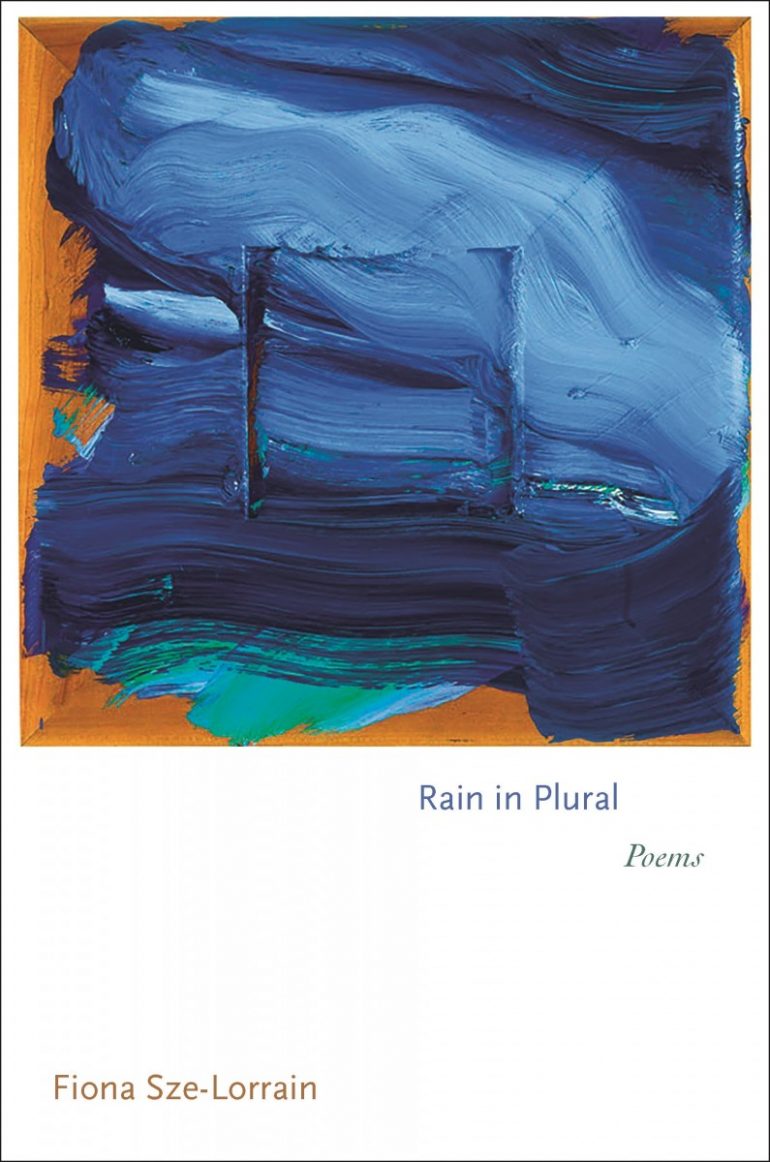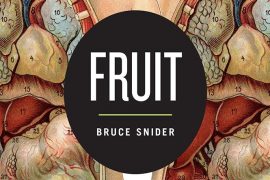Rain in Plural by Fiona Sze-Lorrain. Princeton University Press, 2020. 105 pages. $17.95.
The multiple layers and the angles of Fiona Sze-Lorrain’s fourth collection of poetry, Rain in Plural, offer many doors though which a reader new to Sze-Lorrain’s work might enter: music, philosophy, dance—along with homages and allusions to the work of other writers, other artists. Even before opening Rain in Plural, there is a door within another door: the book’s cover featuring an image of the painting “Déjà vu, Déjà Blue” (2004) by Howard Hodgkin, the title of which references the 1980 power ballad by Dionne Warwick.¹ The painting itself features oversized, multi-layered blues curving in large brush strokes over the carved figure of a square (a visual door). Through this rich visual entrance that reimagines music via a visual art form—a fitting welcome to the poems that follow—the reader meets a speaker immediately in the poem, “More Vulnerable Than Others.” “So what if I break / I will continue to eat mud / unwind underground,” the poem opens. The first lines catch the reader off-guard—if one has assumed “the others” to be other humans, or if one is not prepared for a slide into metaphor. Poems are notoriously sleight of hand this way—their meanings shift underfoot; the ground is not stable, but the net of language itself. To eat mud and “unwind underground” points to growth and thriving that cannot be seen, that is below ground. It opens up, among other things, the idea of not-knowing—how little the reader knows about what is going on even in the natural world around them, the plant world of the yard or the park or even the houseplant, let alone inside another human being. The sheer agency and authority of the speaker is enviable, the poem’s verbs acknowledging the botanical power to break and live on (and even propagate) through breakage, to flourish underground, as well as to
mask banned signs
chew holes in every tall grapevine
breed my roots after a nap
spread fronds as free
clothes free money
The sprawling freedom of the plant that “lay[s] branches bare for the moon and its jaws / while each flower falls / to its own bad dream” is powerful—in part because of the interiority that it speaks to, an interiority reliant on inner resources that the plant has in abundance. Reclining before “the moon and its jaws” is both a vulnerable and a powerful image, the way an animal will roll on its back and expose its belly, secure in its own power to not be harmed by its display of vulnerability. The sonically resplendent closing lines “While each flower falls / to its own bad dream” (the repeating fs and ds remind me of the strong consonance in accentual poems like Beowulf, while the long es are more subtle, more like music spun across the line) makes me wonder if I am missing a reference to a famous poem, or to Baudelaire. This may sound like readerly anxiety, but it is more the kind of wondering to which poems (and art, and science, and human knowledge) are an invitation. There is a delight in knowing there is more to know, more to read, more to experience. There is also delight in recognition, of course, and Sze-Lorrain’s reader might bring any number of musical or poetic references to the reading of her poems.²
But I want to dwell a moment on the idea of interiority—the invisible, glistening fabric of our selves that is entangled with “The visible whose carapace we love,” to quote Jorie Graham’s “Prayer Found Under Floorboard.”³ Interiority is a concept we readily accept, perhaps without realizing how radical a presence it is in some art forms.⁴ It has a relationship to thought, even when it is not thought; it is the well of the self, or the consciousness we think of as the “self” in existential shorthand. The speaker of Sze-Lorrain’s poem “Walking Out on the Lyric” is acquainted with it: “When men take from me all the heat and light, I content myself / with echoes, sounds, and radio waves in every room up for sale inside // this body.” The poem—in long-lined couplets—walks its reader through the spaces of the self, the mind’s furniture, all without saying “mind.” The poem’s speaker describes a visual gallery of interior resources,: “One // of the corners keeps the song alive, another too wet for dust / or sprigs to rot gently. I manage.” The speaker’s moments of confession throughout Rain in Plural—think Jorie Graham or Geoffrey Hill—keeps them in touch with the reader, and does not let the reader forget that the project of art is living, and involves a good deal of imperfection. “[M]ud bricks give up their secrets and poor decisions,” notes the speaker of her body’s rooms.
The non-theistic religion and philosophy of Buddhism also orients the poems in the world, such as “Reincarnated, But Not for the First Time” where the speaker muses “If only the world were as spacious and precise as such a moment, / / I wouldn’t need outlaws and my goddamned pride / I’d be able to fix the smooth decline.” Rather than confession, then, the tones of Sze-Lorrain’s poetry fall along lines of self-reflection or meta-reflection, and often sound like self-scolding; there is a consciousness, always, of what is real in the world. Consider part I (“A Nonreligious Retreat”) of “The Saying and the Said: Ventriloquistic Cloud Chronicles”:
On day one, I ate like a nun:
no meat, no wine. Eager to sleep and Skype someone.
The next day, I carpooled downtown
for a toothbrush—ready to reform my inner life.
On day three, rain checked out of its grand hotel.
I became one of the evergreens, soon to look alike, and not cry.
The formal shift above from couplet to monostich, where the speaker moves from human life and mundane errands (purchase of a toothbrush!) into a metaphoric-spiritual experience of becoming an evergreen, highlights the formal variety and dexterity of Rain in Plural. Truly the book is a library of formal invention, and brings to mind the compliment that Shakespeare’s Enobarbus inadvertently pays Cleopatra: that she is full of “infinite variety.” I spent days slow-reading the book (102 pages of poetry and the notes are filled with treasures), and found something new every time I picked it up again, from one and two-line poems to “plain songs,” to long sequences, to the prose poems comprising the third section “Nine Solitudes,” to apostrophe, ekphrasis, and the zuihitsu form. The poet has not given up on the lyric, but has transformed the lyric’s shape and sound through attention to human history, art, politics. Lyric is an infinitely flexible thing in the hands of Sze-Lorrain, who recently remarked at a reading that she was most interested in how a poem behaves. This interest links her poetry to her playing of the zheng harp as a musician, and to the performance of butoh dance (see the poem “Mimesis: Cloud Chronicle”)—both arts inseparable from their performance in a way that poetry on the page sometimes fails to acknowledge. The movement of music is wound throughout Rain in Plural, and the long poem “Giving Up Thinking Twice” contains both an “[Acoustic]” and an “[Electric]” version of an homage to Bob Dylan, the first of which opens:
Instead of Cohen, I heard another bard.
Some thought him thunder, some found him uphill.
So what if rain must fall hard, one grumbled.
Cut inside each chord, but surrendered for time.
The first, “acoustic” version of “Giving Up Thinking Twice” has long, ranging lines which must break for the page to accommodate them, while the second, “electric” version torques in a column that resembles iambic pentameter (I love that Milton and Paradise Lost are, by association, “Electric”), and closes with a collage of Dylan’s lyrics from “Desolation Row.”
There is something for every reader in Rain in Plural. What is more, there is the sense that the lyric form is uncontainable song that somehow contains itself, but that derives its energy and variety from the tension between the two, in finding its incarnation and reincarnation, again and again, in poetry. As the narcissus flower in the Raku tea bowl in the poem “The Illusion of Tenderness,” which the speaker imagines “floated on matcha from a thousand dinners” and now rests in the speaker’s memory, “roughing out the principle of least action / listening hands down to the chorus, L-o-o-k.” Rain in Plural is an invitation to a myriad of entanglements with the inner life, and what grows from the seeds planted there.
¹ https://howard-hodgkin.com/artwork/deja-vu-deja-blue
² One example is Sze-Lorrain’s poem “Macabre Dance,” to which one might bring knowledge from Saint-Saëns music to Sylvia Plath’s poem.
³ https://www.newyorker.com/magazine/2019/07/29/prayer-found-under-floorboard
⁴ Consider the interiority of women characters in the work of Elena Ferrante, for example: how deep and multiform the thoughts and expressions of Ferrante’s women characters are; to read 20th century novels where women characters have little or no recourse to their own doubts, anger and reasoning can show what a gift of interiority we currently have in contemporary fiction.





